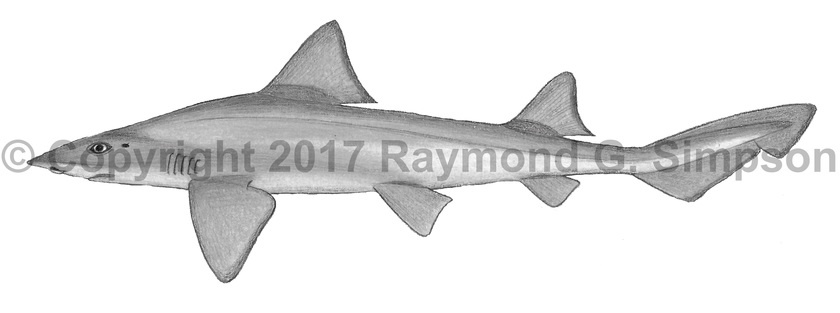
Common Name
Narrownose Smoothhound
Year Described
Springer, 1939
Identification
A small and slender shark with two large dorsal fins. Back strongly humped. Mouth with upper labial furrows much longer than lower furrows. Teeth small and low with stumpy cusps. Upper jaw: 55-60 rows. Lower jaw: 52-55 rows. Eye large with a prominent spiracle less than eye diameter behind it. Snout relatively short. Nostril with projecting tabs. Distance between nostrils 2.7-3.6% TL. Dorsal fins lack spines. Second dorsal fin about 75% as high as the first. First dorsal origin over rear base of pectoral fin. Second dorsal fin origin anterior to anal fin origin but well behind pelvic free tip. Pectoral fin rounded. Pelvic and anal fins much smaller than second dorsal fin. No precaudal pits. Caudal fin with a poorly developed rounded lower lobe. Skin with overlapping *single-pointed denticles with 2-4 ridges.
Color
Body uniformly gray to gray-brown above and pale below. Smaller individuals (<60cm TL) with scattered whitish spots on dorsum. Edge of dorsal fin dark.
Size
Maximum size to 75cm TL.
Habitat
Found in relatively shallow waters from 20-160m.
Range
Southern Brazil to Argentina.
References
Compagno, L., M. Dando, and S. Fowler. 2005. Sharks of the World. Princeton University Press, 480 pp.
Heemstra, P.C. 1997. A review of the smooth-hound sharks (genus Mustelus, family Triakidae) of the western Atlantic Ocean, with descriptions of two new species and a new subspecies. Bulletin of Marine Science, 60(3), 894-928.
Rosa, M.R., & O.B.F. Gadig. 2010. Taxonomic comments and an identification key to species for the Smooth-hound sharks genus (Mustelus Link, 1790) (Chondrichthyes: Triakidae) from the Western South Atlantic. Pan-American Journal of Aquatic Sciences, 401-413.
Other Notes
Records of Mustelus mento from Patagonian waters of the southwestern Atlantic are actually referring to this species.